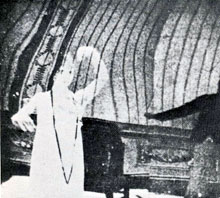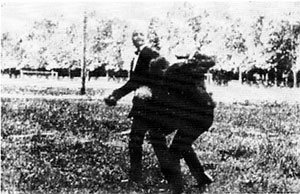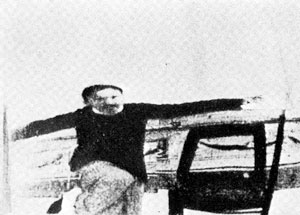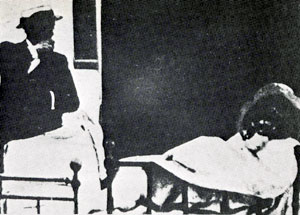Cinema, theatre and photography
The first experiments in avant-garde theatre and cinema.
Music is the most complete creative expression from a scientific-artistic point of view and also the only means of achieving a common condition of the arts. Following this thought, as early as 1909, Arnaldo Ginna and his brother Bruno Corra built an experimental instrument for sound-colour analogy, a sort of chromatic piano consisting of a keyboard to which coloured lights were connected. They also theorised and experimented with a new, non-traditional form of theatrical performance called musical and chromatic drama, in which, with the collaboration of their fellow countryman musician Balilla Pratella, they sought to achieve the full fusion of passion, music, image and colour.

Nevertheless, attempts to accompany the theatrical scene with music and colour failed due to the quality of the technical means at their disposal, so the two artists transported these experiences to cinematography as an ideal instrument to achieve the space-time union. Here are some of Ginna’s notes on the subject:
“Experiences made with colour music, defined as colours presented in an environment and on the screen, with variations in space and time. The lights that imbued the environment with colour were obtained with various electric bulbs controlled by a piano-like keyboard. On the screen, various colours were obtained in the spatial and temporal manner, using the common cinematographic film, photographing various black shapes on a white background so that when developed , they became transparent and had a variety of colours.”
In the text, Chromatic Music of 1912, signed only by Bruno, all stages of the theatrical and cinematic experiments are witnessed and described. The description of the short films made by Ginna and Corra on musical and pictorial themes let us think of ante litteram cartoons, (later much loved by Ginna) with colour-painting applied directly onto blank film, and special effects that were truly prodigious for the time.
Corra was fully aware of the historical importance of these experiments:
“The fruits of this period of experiments, … four rolls of film of which only one exceeds two hundred metres in length, are here, inside my drawer, closed in their boxes, labelled and ready for the future museum (sorry, it’s not pride, it’s just a father’s love for these little children that I like so much with their little rainbow-stained faces and their little mysterious moods).”
Unfortunately, the films were destroyed in a bombing raid, along with Corra’s studio, in Milan during World War II.
Futurist Life.
Thanks to the experience he had gained in filmmaking during the experimental years, Marinetti decided to entrust Ginna with the organisation and production of the film Vita futurista, the first futurist film and probably the first avant-garde film in the history of cinema. Here is how Ginna himself recounts the stages of production of the work:
“It was shot in Florence in the summer of 1916. Marinetti commissioned Arnaldo Ginna to create Vita futurista (Futurist Life), which was to be composed synthetically of short sequences each dedicated to a special futurist psychological problem.” The story continues…

The film was a considerable physical effort and financial commitment for Ginna, since everything fell on his shoulders, as the futurists involved in the project were often undisciplined and lazy due to little sleep, in short, more engaged in goliardic enterprises rather than in work which involved such important results that later would become the matrix of almost all subsequent European avant-garde cinema. One can therefore understand his resentment when, at the beginning of the 1930s, Settimelli tried to take over the total creation of the film by relegating Ginna to the sole activity of technician.
This gave rise to a long diatribe in the pages of the newspapers of the time, which , on the other hand, led to a reaffirmation of Ginna’s paternity, also substantiated by Marinetti’s testimony.
From a number of letters sent by Corra and Ginna to Francesco Balilla Pratella from 1930 onwards, we learn of another interesting project that united these three artists: the making of a film, this time with sound, on a subject by Bruno Corra. The direction was to be Ginna’s while the sound part was naturally entrusted to Balilla Pratella. The project started in 1930, Ginna and his brother Francesco, an engineer, built a kind of amplifier capable of transmitting ‘all musical frequencies’. In all probability, the film was never realised.

The same fate befell a later project, in 1936, which primarily involved Corra and Pratella in the making of a musical film entitled Balilla e Tonietta. Ginna collaborated in the drafting of the script but the subject did not get the approval of the general direction of cinematography chaired, among others, by Pratella’s cousin . This was Ginna’s last non-theorist approach to filmmaking.
In 1938 Ginna, co-signed, La cinematografia (Cinematography), with Marinetti, updating the text of the 1916 manifesto with the new technical discoveries of the last twenty years: sound, dubbing, new machinery and new shooting criteria.
Film criticism, radio and cine-sound.
Around 1910, the interest in a new artistic criticism, both literary and pictorial, is present from Ginna’s earliest theoretical texts and fits in perfectly with the new current of literary criticism advocated by Emilio Settimelli and Mario Carli in the Florentine magazine Il Centauro. Thus, Arnaldo Ginna’s activity as a critic began in 1912, when he published a short essay on the actor Luigi Savini and the film actress Nadia Napierkowska ,within a critical text by Settimelli.

Subsequently, from the second half of the 1920s, his activity as a journalist and critic especially developed with his collaboration in the editorial offices of newspapers and magazines connected with the Futurist Movement: since 1926, with L’Impero and since 1930, with Oggi e Domani and Futurismo. From these pages Ginna, in addition to publishing short stories and illustrations, dealt mainly with radio, cinema, film criticism and sound.
As a critic but also as a technician, he deals with problems scientifically, relating to radio broadcast reception systems, projection machines, film quality, editing and dubbing techniques in cinema, amplification and acoustic quality. They are often interesting and innovative articles, sometimes posing anticipatory questions on the later developments of these media.
Ginna wrote as early as 1928 about the Art of Radio or Phonic Art and was the first to pose the problem of ‘codifying’ this new art from an aesthetic and technical point of view. In 1932, he also wrote of Futurist Criticism applying the theses advocated by the Futurist manifesto Pesi misure e prezzi del genio artistico to film criticism, signed by Corra and Settimelli in 1914, in which criticism also became an exact science with which to consider the new art: a film work, in order to be scientifically understood, must be evaluated according to the various activities that compose it under separate headings:
“Cinesonoric, theatrical, pictorial, etc., criticism should be, as much as it can be, fast synthetic and precisely valorising: it should rather be called evaluation… for example a cine-sound work is composed of various inseparable but clearly distinguishable parts: ‘Interweaving. Pictures. Sound. Acting’… Futurist evaluation must tend towards the most synthetic form of evaluation that expressed by a numerical fraction.”
This is a truly current vision, a technique found in modern film classification criteria.
Photography.
The camera accompanies Ginna throughout his artistic career. He often calls himself a photographer, and rightly so, since photography, used for experimental artistic purposes, has been an indispensable tool in his work since the early 1910s. Almost all the photographic experiments that Ginna carried out in those years have been lost, but what remains testifies to a truly innovative work practised with colour directly on blank or sometimes already impressed film, in order to continue to achieve new results that were ahead of the time.
However, many photographs of landscapes and portrait photos, remain as evidence of other research, studies carried out by Ginna in his later years. In fact, for the artist, photography is a means of achieving the spiritualisation of painting: by photographing the chosen subject, he extrapolates it from its context and edulcates it from its immediate visual and emotional sensations. Then, transferring it into painting, he enriches it with lines and colours that are no longer the natural ones but are ‘lyricised’ and spiritualised, in an attempt to fully embody the spirituality of the ultra-sensistive.
Text by Lucia Collarile.
